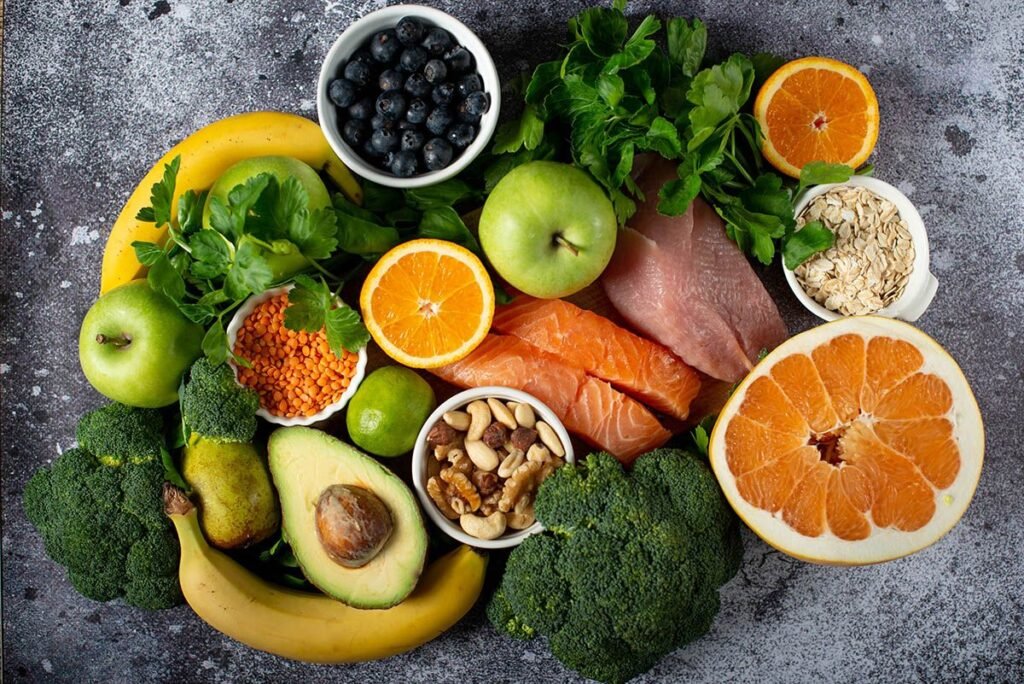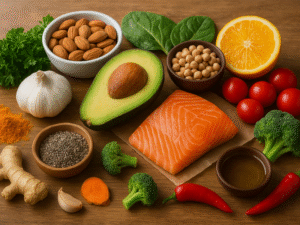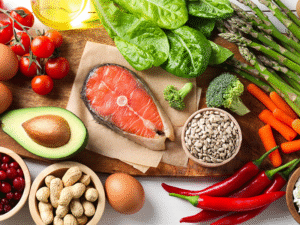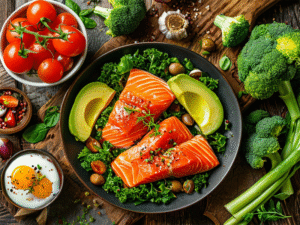Managing Type 2 diabetes after 60 isn’t just about medication — what you eat plays a crucial role in keeping your blood sugar stable, maintaining a healthy weight, and preventing complications. The good news? You don’t have to give up flavor or variety to eat well.
This guide covers everything you need to know, including:
- The best foods to include in your diet
- How to choose the right carbohydrates
- Tasty and diabetic-friendly breakfast ideas
- Step-by-step meal planning tips
Part 1: The Best Foods for Seniors Managing Type 2 Diabetes
Choosing the right foods can make a huge difference in your overall health and energy levels. These diabetes-friendly foods are packed with nutrients and help keep blood sugar steady throughout the day.
1. Fiber-Rich Vegetables
Fiber slows down digestion and helps prevent blood sugar spikes.
Top choices include:
- Leafy greens like spinach, kale, and Swiss chard
- Broccoli and cauliflower
- Bell peppers
- Zucchini and squash
- Green beans
Pro Tip:
Fill half your plate with non-starchy vegetables for maximum benefit.
2. Lean Proteins
Protein helps you feel full longer and supports muscle strength, which is essential as you age.
Great options:
- Skinless chicken or turkey
- Fish, especially salmon and sardines (rich in omega-3s)
- Eggs
- Greek yogurt
- Plant-based proteins like lentils, beans, and tofu
3. Healthy Fats
Not all fats are bad! Healthy fats improve heart health and can help stabilize blood sugar when eaten in moderation.
Sources to include:
- Avocados
- Nuts and seeds (almonds, chia, flaxseed)
- Olive oil
- Fatty fish like salmon or mackerel
4. Whole Grains
Whole grains are higher in fiber than refined grains, making them better for blood sugar control.
Examples:
- Oats
- Brown rice
- Quinoa
- Barley
- Whole wheat bread or pasta
5. Low-Sugar Fruits
Fruits are naturally sweet, but some have a lower glycemic index, meaning they won’t cause big spikes in blood sugar.
Best picks:
- Berries (blueberries, raspberries, strawberries)
- Apples and pears
- Oranges
- Grapefruit
- Kiwi
6. Hydration Helpers
Staying hydrated helps flush out excess glucose and keeps your body functioning well.
Choose:
- Water
- Unsweetened tea or coffee
- Infused water with lemon or cucumber
Avoid:
- Sugary drinks
- Sweetened juices
- Regular soda
Summary:
A balanced diet includes plenty of fiber, lean proteins, and healthy fats, with controlled portions of whole grains and low-sugar fruits.
Part 2: Carbs Aren’t the Enemy – Choosing the Right Carbohydrates
Carbohydrates often get a bad reputation, but they are essential for energy — especially as we age. The key is choosing quality carbs and balancing them properly.
Understanding Simple vs. Complex Carbs
- Simple carbs are digested quickly, causing blood sugar to spike.
Examples: White bread, pastries, candy, sugary drinks. - Complex carbs digest more slowly, leading to steadier blood sugar levels.
Examples: Whole grains, beans, lentils, vegetables.
Rule of thumb:
Choose complex carbs and pair them with protein or healthy fats to balance blood sugar.
How to Build a Carb-Friendly Plate
- Half your plate: Non-starchy vegetables
- One-quarter: Lean protein
- One-quarter: Complex carbs like brown rice or quinoa
Carb Counting Made Simple
Carb counting helps you understand how different foods affect your blood sugar.
General guidelines for seniors with diabetes:
- Men: 45–60 grams of carbs per meal
- Women: 30–45 grams of carbs per meal
Examples:
- 1 slice of whole wheat bread = ~15 grams
- ½ cup cooked oatmeal = ~15 grams
- 1 small apple = ~15 grams
Smart Swaps for Better Blood Sugar Control
| Instead of this… | Try this instead… |
| White rice | Brown rice or quinoa |
| Sugary cereal | Oatmeal with berries |
| Regular pasta | Whole grain or lentil pasta |
| Soda | Sparkling water with lime |
| White bread | Whole grain bread |
Tip:
Don’t cut carbs completely — just choose wisely and control portions.
Part 3: 7 Delicious and Diabetic-Friendly Breakfast Ideas
Breakfast sets the tone for your whole day. The right morning meal helps maintain energy and prevents mid-morning sugar crashes.
Here are seven tasty, balanced, and blood-sugar-friendly breakfast ideas:
1. Greek Yogurt Parfait
- ½ cup plain Greek yogurt
- ¼ cup fresh berries
- 1 tablespoon chia seeds
- Sprinkle of cinnamon
Why it works:
High protein and fiber, low sugar.
2. Veggie Omelet
- 2 eggs or egg whites
- Spinach, mushrooms, and tomatoes
- 1 teaspoon olive oil
Pro Tip:
Add a slice of whole grain toast for extra fiber.
3. Overnight Oats
- ½ cup rolled oats
- ½ cup unsweetened almond milk
- 1 tablespoon peanut butter
- A few blueberries on top
Make ahead:
Perfect for busy mornings.
4. Avocado Toast
- 1 slice whole grain bread
- ½ avocado, mashed
- Sprinkle of chia or flax seeds
Variation:
Add a poached egg for extra protein.
5. Cottage Cheese Bowl
- ½ cup low-fat cottage cheese
- Sliced strawberries or peaches
- Handful of walnuts
6. Breakfast Burrito
- Whole wheat tortilla
- Scrambled eggs
- Black beans
- Salsa and a sprinkle of cheese
7. Smoothie with Greens
- 1 cup unsweetened almond milk
- 1 handful spinach
- ½ banana
- 1 tablespoon almond butter
- Scoop of protein powder (optional)
Note:
Avoid high-sugar breakfast options like pastries, donuts, and sugary cereals.
Part 4: Meal Planning 101 – A Beginner’s Guide for Seniors with Diabetes
Meal planning helps you stay consistent, reduce stress, and avoid unhealthy last-minute choices.
Step 1: Plan Your Portions
Use the “Diabetes Plate Method” to simplify portion control:
- ½ plate: Non-starchy vegetables
- ¼ plate: Lean protein
- ¼ plate: Complex carbs
Step 2: Set a Meal Schedule
Consistency is key. Try to eat three balanced meals and one or two snacks at roughly the same times each day.
Why it matters:
It prevents extreme blood sugar highs and lows.
Step 3: Prep Ahead
- Batch cook grains like brown rice or quinoa.
- Pre-chop veggies for salads or stir-fries.
- Cook extra portions of lean protein to use in different meals.
Step 4: Healthy Snack Ideas
Keep blood sugar steady between meals with small, balanced snacks:
- A handful of almonds
- Baby carrots with hummus
- Apple slices with peanut butter
- Cheese stick with cucumber slices
Step 5: Grocery Shopping Tips
- Shop the perimeter: Most whole, fresh foods are located along the edges of the store.
- Read labels: Look for hidden sugars and unhealthy fats.
- Stick to a list: Helps avoid impulse buys.
Step 6: Example Day of Meals
Breakfast: Greek yogurt parfait with berries
Lunch: Grilled chicken, roasted vegetables, and quinoa
Snack: Apple slices with almond butter
Dinner: Baked salmon, green beans, and brown rice
Evening snack: Cottage cheese with cinnamon
Final Thoughts
Managing diabetes through diet doesn’t mean deprivation — it means making smarter, more balanced choices.
By:
- Choosing nutrient-rich foods,
- Managing portion sizes,
- And planning meals ahead,
You can keep blood sugar stable, enjoy delicious meals, and support your long-term health.





